非谓语动词doing和done做状语的用法技巧
高考英语非谓语动词作状语的用法 知识点
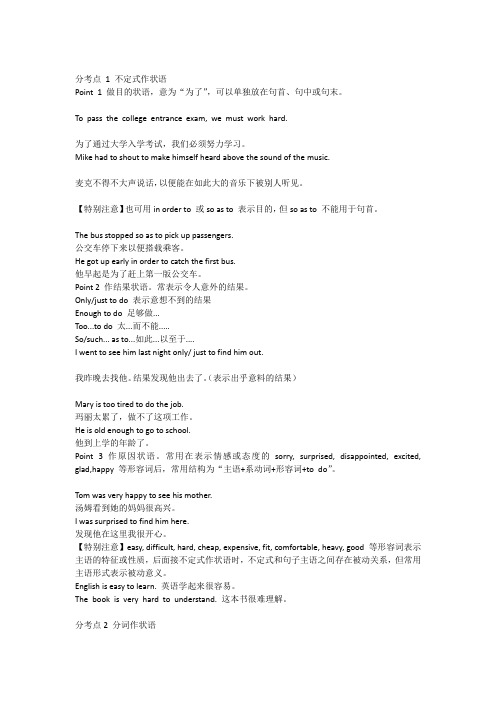
分考点1 不定式作状语Point 1 做目的状语,意为“为了”,可以单独放在句首、句中或句末。
To pass the college entrance exam, we must work hard.为了通过大学入学考试,我们必须努力学习。
Mike had to shout to make himself heard above the sound of the music.麦克不得不大声说话,以便能在如此大的音乐下被别人听见。
【特别注意】也可用in order to 或so as to 表示目的,但so as to 不能用于句首。
The bus stopped so as to pick up passengers.公交车停下来以便搭载乘客。
He got up early in order to catch the first bus.他早起是为了赶上第一版公交车。
Point 2 作结果状语。
常表示令人意外的结果。
Only/just to do 表示意想不到的结果Enough to do 足够做...Too...to do 太...而不能.....So/such... as to...如此...以至于....I went to see him last night only/ just to find him out.我昨晚去找他。
结果发现他出去了。
(表示出乎意料的结果)Mary is too tired to do the job.玛丽太累了,做不了这项工作。
He is old enough to go to school.他到上学的年龄了。
Point 3 作原因状语。
常用在表示情感或态度的sorry, surprised, disappointed, excited, glad,happy 等形容词后,常用结构为“主语+系动词+形容词+to do”。
Tom was very happy to see his mother.汤姆看到她的妈妈很高兴。
非谓语动词做定语状语和主语的讲练

3. 为了通过期末考试,他熬夜到很晚,这导致他生病了。 事实上,对他来说短时间内取得大进步是很困难的。
3.你借给我如此多的书真是太好心了。
It is kind of you to lend me so many books.
4.如果你想学好英语,每天朗读半个小时是很重 要的。
It is very important to read English for half an hour every day if you want to learn English well.
非谓语动词做定语的练习
I. 语法填空单句练习:
1. We saw an exciting (excite) film last night. 2. The puzzled (puzzle) look on his face suggested that he didn’t know the lady at all. 3. That day, they had nothing to eat (eat).
To / In order to pass the final exam, he stayed up very late, resulting in his illness. In fact, it was rather difficult for him to make great/rapid progress in a short time.
非谓语动词做主语的练习
It is/was + adj. + (for/of sb.) to do sth. 1.对我们来说学好英语很有必要。
非谓语动词用法总结

非谓语动词用法总结非谓语动词是历年高考英语的重要考点之一,同时也是较难掌握的难点之一。
它贯穿于英语学习和考试过程的始终。
但是,只要认真分析、透彻理解、看透本质、准确把握,就一定能在高考中运筹帷幄,游刃有余。
一.非谓语动词区别简表二.不定式的用法不定式不可作谓语,但它可以有自己的宾语、状语,构成不定式短语,在句中可以作主语、宾语、表语、定语(表用途)、状语或补足语。
高考对不定式的考查主要有不定式的时态、语态、作用、否定、省略、连词+不定式等。
作主语不定式作主语表示具体的动作,通常指一件已知的事或目的。
不定式作主语时,谓语动词用单数。
eg:To say is a thing,to do is another.(说是一回事,做是另外一回事。
)(2)不定式短语较长时,通常放在谓语之后,用it作形式主语。
eg:①It is important to learn English well.(学好英语是重要的。
)②It is necessary for us to do the job well.(我们做好这项工作是必要的。
)③It is a great honor to be invited to give a speech here.(被邀请在这儿发表演讲是一个极大的荣幸。
)2.作宾语(1)常只用不定式作宾语的动词有:want,wish,hope,long,expect,desire,intend,decid e,ask,promise,aim,offer,agree,plan,learn,choos e,refuse,fail,manage,pretend等。
eg:①He refused to help me.(他拒绝帮助我.)②She has agreed to come tomorrow.(他已同意明天来.)(2) 不定式较长时,作宾语,也可用it代替,放在后面。
eg;I find it difficult to do the job well.(3) “特殊疑问词﹢不定式to do结构”具有名词特征,可作宾语。
非谓语动词做状语

二. done/being done/having been done 做状语 主语与非谓语动词之间为被动关系; having been done 发生在主句谓语动词之前
1. Seen from the top of the mountain, the city looks beautiful.
2. Compared with those who lived in the slums, Children here are really lucky.
过去分词可以以下成分:
1.表语 The teacher is moved. 2. 定语 I don’t like the man talked about at the party. 3. 宾补 We heard a song sung in her room. 4. 状语 Lost in a newspaper, She didn’t notice me.
He is too careful not to have noticed that. 他那么小心,肯定会注意到那一点的。 She is too sad not to help crying. 她那么伤心,忍不住哭了。 I am only too glad to help you.我很高兴能帮助你。 I am only never too glad to know you. 认识你我再高兴不过了。
s )
一. 非谓语动词做状语的形式: 二. doing/ having done 三. done/being done/having been done 四. to do/ to be done
五. 二. 做题方法:析句子结构,找逻辑主语, 辩逻辑关系,判动词先后
If I am given more time, I’ ll catch up with you.
高考英语之非谓语动词作状语
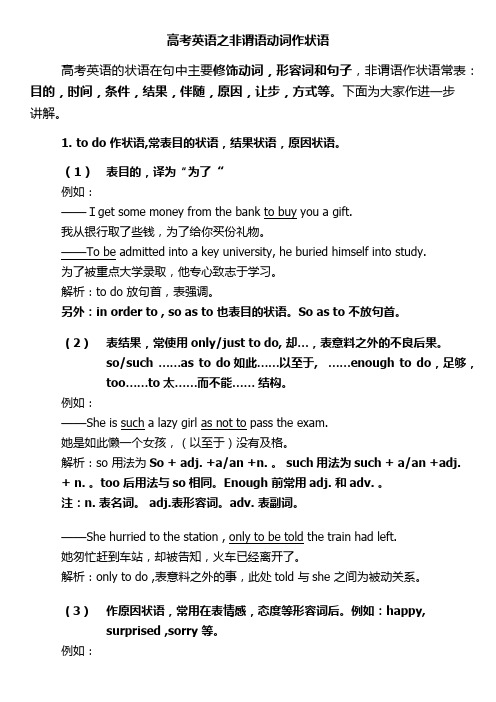
高考英语之非谓语动词作状语高考英语的状语在句中主要修饰动词,形容词和句子,非谓语作状语常表:目的,时间,条件,结果,伴随,原因,让步,方式等。
下面为大家作进一步讲解。
1.to do 作状语,常表目的状语,结果状语,原因状语。
(1)表目的,译为“为了“例如:——Iget some money from the bank to buy you a gift.我从银行取了些钱,为了给你买份礼物。
——To be admitted into a key university, he buried himself into study.为了被重点大学录取,他专心致志于学习。
解析:to do 放句首,表强调。
另外:in order to , so as to 也表目的状语。
So as to 不放句首。
(2)表结果,常使用only/just to do, 却…,表意料之外的不良后果。
so/such ……as to do如此……以至于, ……enough to do,足够,too……to太……而不能……结构。
例如:——She is such a lazy girl as not to pass the exam.她是如此懒一个女孩,(以至于)没有及格。
解析:so 用法为So + adj. +a/an +n. 。
such用法为such + a/an +adj.+ n. 。
too 后用法与so相同。
Enough 前常用adj. 和adv. 。
注:n. 表名词。
adj.表形容词。
adv. 表副词。
——She hurried to the station , only to be told the train had left.她匆忙赶到车站,却被告知,火车已经离开了。
解析:only to do ,表意料之外的事,此处told 与she 之间为被动关系。
(3)作原因状语,常用在表情感,态度等形容词后。
例如:happy,surprised ,sorry 等。
非谓语动词在句首的用法

非谓语动词在句首的用法在英语学习中,非谓语动词是一个重要且具有一定难度的语法点。
当非谓语动词出现在句首时,其用法更是需要我们仔细分辨和理解。
非谓语动词包括动词不定式(to do)、动名词(doing)和分词(现在分词 doing 和过去分词 done)。
首先,我们来谈谈动词不定式置于句首的情况。
动词不定式在句首通常用作目的状语,表示某一动作的目的。
例如:“To learn English well, we need to practice speaking every day”(为了学好英语,我们需要每天练习说。
)这里的“To learn English well”就是目的状语,清晰地表明了后面“we need to practice speaking every day”这个行为的目的。
另外,动词不定式在句首有时也用作主语,表示某个具体的动作或行为。
例如:“To err is human; to forgive, divine”(人孰无过;宽恕乃神圣之举。
)在这个句子中,“To err”和“To forgive”分别充当了两个分句的主语。
接下来是动名词在句首的用法。
动名词在句首通常作主语,表示一个一般性的、习惯性的动作或状态。
比如:“Doing exercise regularly is good for our health”(经常做运动对我们的健康有好处。
)这里“Doing exercise regularly”就是一个习惯性的动作,被用作主语来阐述其对健康的影响。
动名词在句首还可以作表语,用来描述主语的性质或状态。
例如:“Her job is teaching English”(她的工作是教英语。
)“Teaching English”在这个句子中作表语,说明了“Her job”的性质。
再说说现在分词在句首的情况。
现在分词在句首作状语时,往往表示伴随、原因、时间等。
例如:“Walking along the street, I saw an old friend”(沿着街道走的时候,我看到了一位老朋友。
非谓语动词动词-ing之用法精讲

B 动词-ing形式的完成式
动词-ing形式的完成式表示一个已完成的动作,这个动 作发生或完成在谓语动词表示的动作之前。
Having lived in this city for three years, she knows it very well.
点津坊
在现代英语中,作宾语的动词-ing形式的完成式可用一 般式来代替。
go on doing★ 继续做同一件事。
Though it was raining heavily, they went on working。
mean to do★ 想要做某事
I didn‘t mean to hurt you. 。
mean doing★ 意味着要有一个结果
Missing the train means waiting for another hour. 。
forget doing★忘记以前曾做过的事
I'll never forget meeting my school headmaster for the first time.
stop to do★停止原来做的事,开始做另一件事
While working, he stopped to talk with Tom at times.
非谓语动词doing的用法总结

非谓语动词doing的用法总结
非谓语动词doing的用法总结如下:
1. 做主语:Doing exercises regularly helps improve physical fitness.
经常做运动有助于提高身体健康。
2. 做宾语:I enjoy doing yoga.
我喜欢做瑜伽。
3. 做定语:A living room is a place for doing various activities.
客厅是进行各种活动的地方。
4. 做补语:He kept on doing the same mistake.
他一直在犯着同样的错误。
5. 做状语:She left, doing her best to hide her tears.
她离开时,竭尽全力掩饰自己的眼泪。
6. 做同位语:Her favorite hobby, doing crossword puzzles, keeps her mind sharp.
她最喜欢的爱好——填字游戏,使她的头脑保持敏锐。
7. 做宾语补足语:We found him sitting alone in the park.
我们发现他独自坐在公园里。
总结:非谓语动词doing可以在句子中充当主语、宾语、定语、补语、状语、同位语以及宾语补足语的角色。
高二英语非谓语动词做状语

Having been done done
主动,进行 被动,进行 主动,完成 被动,完成
1.被动2.完成3. 被动,完成
题型结构:
• _______________________,S+V+O. (多把表时间,原因,条件,目的状语等 放句前)
• S+V+O,_________________________. (表结果,伴随的状语等放句后)
• (He walked down the hill and sang softly to himself.)
• Kneeling and shutting her eyes, she prayed to the goddess.
• She stood by the window watching the sunsets.
• He walked down the hill and sang softly to himself.
• 逗号前后没有连词连接(and, but, when, as, where, however,等),就构成了非谓语 做状语的基本前提.
• 现在分词的主动式主要是与句中主语逻辑 上的一种主谓关系,现在分词的被动式主 要是与句中主语逻辑上的一种动宾关系; 现在分词的进行式是指分词所表示的动作 (或状态)与句中动作同时或几乎同时发 生,现在分词的完成式是指分词所表示的 动作(或 状态)一定先于句中谓语动作发 生。
• Granting his honesty, we still can’t employ him.就算他是诚实的,我们也不能 雇佣他。
• 作方式或伴随状语不能用状语从句替换,但可 以改成并列句,通常放句后。
• He walked down the hill, singing softly to himself.
英语非谓语动词doing done 的用法区别

英语非谓语动词doing done 的用法区别英语中的非谓语动词doing和done是现在分词和过去分词两种形式,它们作为非谓语动词时,在句子中扮演不同的角色,具有不同的意义和用法:1. 现在分词(doing)- 用作定语:现在分词通常表示主动和正在进行的动作。
示例:A sleeping baby (正在睡觉的婴儿)- 用作表语:表示主语的特征或状态,意为“令人……的”。
示例:The book is interesting. (这本书很有趣)- 用作状语:常表示同时发生或者伴随的动作,与主句的主语之间是逻辑上的主谓关系。
示例:She came into the room, wearing a red dress. (她穿着一件红裙子走进房间)2. 过去分词(done)- 用作定语:过去分词通常表示被动或完成的动作。
示例:A completed project (已完成的项目)- 用作表语:表示主语的状态,尤其是经过被动动作后所处的状态或主观感受。
示例:She feels tired after the long run. (长跑后她感到累)- 用作状语:它同样可以表示被动或已经完成的动作,与主句主语之间是被动关系。
示例:Given enough time, she would finish the task. (如果给她足够的时间,她就能完成任务)- 另外,过去分词还可用于构成被动语态,与助动词be结合使用。
示例:The homework was finished by the student. (作业被学生完成了) 总结来说,现在分词doing一般表示主动、进行或动态的特征,而过去分词done多表示被动、完成或静态的结果。
在具体应用中,还需结合语境和语法结构来正确使用。
非谓语动词doing和done做状语的用法技巧
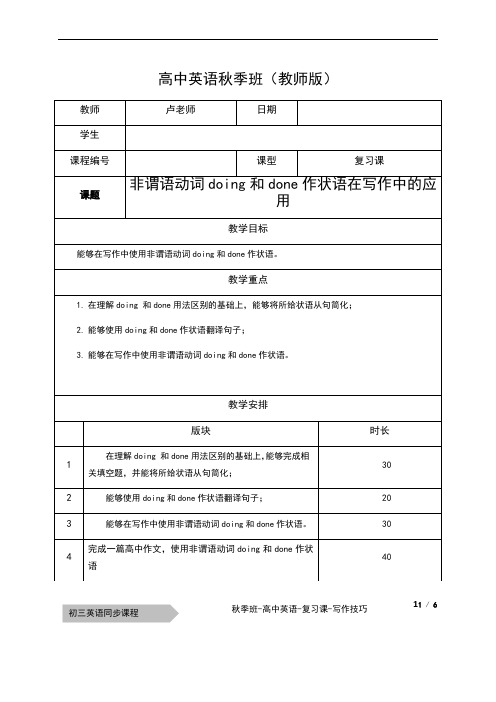
高中英语秋季班(教师版)11 / 6初三英语同步课程秋季班-高中英语-复习课-写作技巧22 / 6初三英语同步课程秋季班-高中英语-复习课-写作技巧v1.0 可编辑可修改33 / 6初三英语同步课程 秋季班-高中英语-复习课-写作技巧一、用动词的适当形式填空:非谓语动词作状语大多相当于一个状语从句A.作时间状语:eg.)①_______ (hear) the bad news, they couldn’t help crying.= _______________, they couldn’t help crying.②When/ While( _____ _____ ) ____ (take) around the city, we were deeply impressed by the city’s new look.While/When (I was) _____ (wander) through the square, I caught sight of a snake-charmer. ③_______ (finish) his work, he went home.=_____________, he went home.B.作原因状语:Eg.) ①_____ (be poor), he could not afford to travel abroad.=____________, he could not afford to travel abroad.________ (encourage) by his heroic deeds, they worked harder._______ (lose) in thought, he almost ran into a post.________ (frighten) by the big forest fire, the animals all ran away._____ (not know) her address, we couldn't get in touch with her.②______ (never be) to the city, he soon got lost._________ (not receive) his letter, I decided to call him up.知识点讲解=_____________.C.方式/伴随状语;Eg.)①She watched the film, _____ (weep ) and ___ (sigh).②The teacher stood there, ______ (surround) by a lot of students.D.作条件状语:Eg.)①______ (give) another chance, I would have done the job far better.=______________ , I would have done the job far better.②(If) _____ (play) all day, you will waste your valuable time.E.作结果状语:(意料中的结果)Eg.)① The hunters fired, _____(shoot) one of the wolves.②The bus was held up by the snowstorm, thus _____ (cause) the delay.区别: 不定式表示意外的结果eg.) He hurried to the station, only ____ (find) the train had left.F.作让步状语:Eg.)①Though ____ (rain) heavily, it cleared up very soon.= _____________, it cleared up very soon.②Though _____ (tell) of the danger, he still risked his life to save the boy.分词作状语时, 需注意事项:A.分词短语作状语时,它的逻辑主语通常应是________ :____ (see) from the hill, the city is beautiful.___ (see) from the hill, you can see the whole city二、使用doing和done简化以下状语从句:44 / 6初三英语同步课程秋季班-高中英语-复习课-写作技巧1.When arriving, send me a telegram. (When you arrive, send me a telegram.) 到达之后,来个电报。
非谓语动词的六大用法
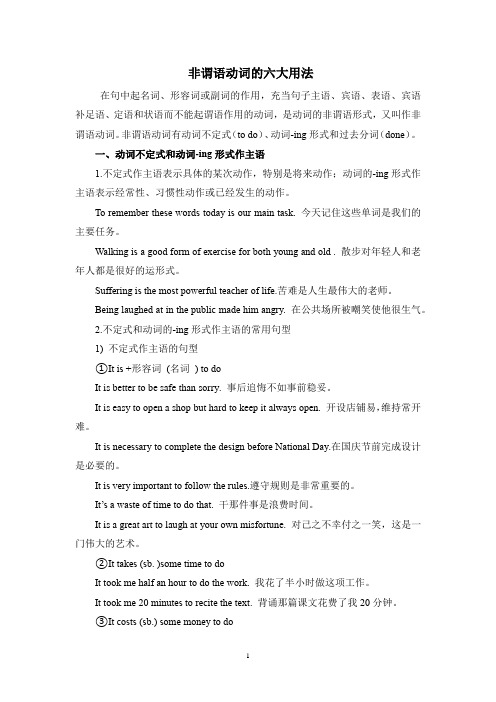
非谓语动词的六大用法在句中起名词、形容词或副词的作用,充当句子主语、宾语、表语、宾语补足语、定语和状语而不能起谓语作用的动词,是动词的非谓语形式,又叫作非谓语动词。
非谓语动词有动词不定式(to do)、动词-ing形式和过去分词(done)。
一、动词不定式和动词-ing形式作主语1.不定式作主语表示具体的某次动作,特别是将来动作;动词的-ing形式作主语表示经常性、习惯性动作或已经发生的动作。
To remember these words today is our main task. 今天记住这些单词是我们的主要任务。
Walking is a good form of exercise for both young and old . 散步对年轻人和老年人都是很好的运形式。
Suffering is the most powerful teacher of life.苦难是人生最伟大的老师。
Being laughed at in the public made him angry. 在公共场所被嘲笑使他很生气。
2.不定式和动词的-ing形式作主语的常用句型1) 不定式作主语的句型①It is +形容词(名词) to doIt is better to be safe than sorry. 事后追悔不如事前稳妥。
It is easy to open a shop but hard to keep it always open. 开设店铺易,维持常开难。
It is necessary to complete the design before National Day.在国庆节前完成设计是必要的。
It is very important to follow the rules.遵守规则是非常重要的。
It’s a waste of time to do that. 干那件事是浪费时间。
It is a great art to laugh at your own misfortune. 对己之不幸付之一笑,这是一门伟大的艺术。
高中英语语法填空之非谓语动词作状语和补语

语法填空之非谓语动词作状语和补语1.分析逻辑关系(1)作状语:①表目的、出乎意料的结果或在形容词后作状语,用不定式;②表伴随、时间或条件等要用现在分词/过去分词;③表自然而然的结果用现在分词。
(2)作补语:根据具体结构用(to) do/doing/done①如逻辑主语与非谓语动词之间是主谓关系,且表正在进行,用doing。
②如逻辑主语与非谓语动词之间是被动关系,且表完成,用done。
2.牢记5种用法①不定式作宾补:allow、ask、beg、command、encourage、expect、forbid、invite、persuade、tell等+sb. to do sth.。
②用省略to的不定式作宾补的动词:“五”看;“三”使;“两”听;“一”感觉。
“look at/see/watch/notice/observe; make/let/have; hear/listen to; feel”+sb.+do sth.。
注意:但在被动语态中作主语补足语要还原to,如be_made_to_do。
③have sb./sth.doing “让某人/某物一直做”;have sb./sth.done “让某人/某物被做”。
④主语+系动词+形容词(easy、hard、impossible、important等)+to do⑤too+adj./adv.+to do或adj./adv.+enough+to do3.固定句型识记不定式作补语:advise sb. to do allow sb. to do ask sb. to dobeg sb. to do cause sb. to do encourage sb. to do expect sb. to do forbid sb. to do force sb. to do help sb. (to) do invite sb. to do inspire sb. to do order sb. to do permit sb. to dopersuade sb. to dorequire sb. to doremind sb.to dotell sb. to dowant sb. to dowarn sb. to dowish sb. to dowait for sb. to docall on sb. to do 号召某人去做rely on sb. to do 指望某人做某事-ing 作补语catch sb. doing 发现、撞见某人做某事find sb. doing 发现某人做某事keep sb./sth. doing 使...处于...状态leave sb./sth doing 使...处于...状态课堂练习1.On the last day of our week-long stay, we were invited to attend a private concert on a beautiful farm on the North Shore under the stars, ________ (listen) to musicians and meeting interesting locals.2.You don't have to run fast or for long________ (see) the benefit.3.The government encourages farmers to grow corn instead of rice________ (improve) water quality.4.Once his message was delivered, he allowed me________ (stay) and watch. 5.They are required________ (process) the food that we eat, to recover from injury and for several other bodily functions.6.Nervously ________ (face) challenges, I know I will whisper to myself the two simple words “Be yourself”.7 ________ (enjoy)the convenience of digital payment, many senior citizens started to use smart phones.8.Ordinary soap,________ (use) correctly, can deal with bacteria effectively. 9.I need a new passport so I will have to have my photographs________ (take).10.People probably cooked their food in large pots, ________ (use) twigs (树枝) to remove it.课后练习Gabi Rizea only discovered his talent for woodcarving three years ago,and has since put 1to good use,saving dozens of old tree stumps (树桩) from 2 (remove) by turning them into impressive works of art.Rizea became a woodcarver 3(complete) by accident.Three years ago,after buying himself a new chainsaw(链锯),he 4(start) “playing” with it on a block of wood.He tried carving a human face into the wood,and to his surprise,it turned out pretty good.Today,he is so good at woodcarving that his home city allows him to workhis magic on old tree stumps and so far about 40 works of art 5(create) in the local parks.“In 99% of the cases,the wood just doesn’t match my ideas,” he said in an interview.“I first have to remove all the rotten parts,and sometimes,6is left isn’t enough for my designs.”Following his recent rise to fame,Rizea has been asked by many 7 (city),including the capital of Romania to transform their old tree trunks 8 works of art.He promises to honor their requests,but he will never repeat any of the artworks 9(find) in his home city.In spite of his obvious talent,the Romanian 10(art) recently got into an art school in order to fully master woodcarving.参考答案:1.it 2.being pletely4.started5.have been created6.what7.cities8.into9.found10.artist课后练习(二)How would you feel if you woke up and found your information in the computer—including your photos,your recent documents—no longer 1 (access)?What if you found out that they had been wiped from your computer, 2 (leave) you with nothing but heartache?Guess what?It happens to people every single day.Every day,people across the country head into their local Apple store in 3(tear),broken computer in hand,praying as they wait in line 4an expensive repair might,just might,recover the priceless,irreplaceable files.A few get lucky. 5for the rest,there’s nothing anyone can do 6(help).Hasn’t it happened to you?If your computer remains unprotected,it will,and it’s only 7matter of time.But thanks to recent breakthroughs in computer backup(备份) technology,you now have a number of options to choose from,and if you’re smart,when your computer 8(crash),you shouldn’t have any trouble 9(get) 100% of your files back that same day.I’m not talking about an external hard drive.I’m talking about an online backup solution that runs 10(quiet) inthe background on your computer.If you have one installed (安装),when your computer crashes,you’ll be just one click away from bringing your files back to life.参考答案:1.accessible2.leaving3.tears4.that5.But6.to help7.a8.crashes9.getting10.quietly。
英语非谓语动词用法全面归纳
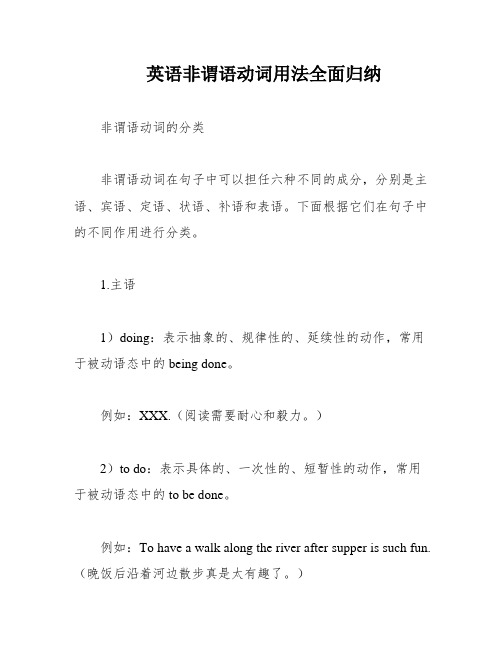
英语非谓语动词用法全面归纳非谓语动词的分类非谓语动词在句子中可以担任六种不同的成分,分别是主语、宾语、定语、状语、补语和表语。
下面根据它们在句子中的不同作用进行分类。
1.主语1)doing:表示抽象的、规律性的、延续性的动作,常用于被动语态中的being done。
例如:XXX.(阅读需要耐心和毅力。
)2)to do:表示具体的、一次性的、短暂性的动作,常用于被动语态中的to be done。
例如:To have a walk along the river after supper is such fun.(晚饭后沿着河边散步真是太有趣了。
)3)注意:①to do经常用it作形式主语替代逻辑主语放在句首,而真正的逻辑主语放在句末。
一般形式有:a。
it’s + adj + to do sth;b。
it + vt + o(宾语) + to do sth。
例如:It’s important to have a good eyesight。
as it’s known to us.(拥有良好的视力很重要,这是我们所知道的。
)It took me 3 days to finish the task.(我用了三天时间完成了这个任务。
)②it作形式主语替代doing的几个结构,如:it’s nouse/useless,it’s a waste of time,it’s no good等。
例如:It’XXX.(覆水难收。
)③范例:1)To the sun for too long contributes to the harm to the skin.A。
Being exposedB。
ExposedXXXD。
XXX解析:选A。
有可能误选B,因为可能误认为句子缺少状语,但实际上这个短语作为状语的话,句子就没有主语了。
正确的判断方法是划分句子的主谓宾。
2)动名词的复合结构:one’s doing/being done。
非谓语动词作状语技巧

非谓语动词作状语技巧非谓语动词作状语是一种常见的修饰手法,它可以在句子中充当状语,起到进一步修饰动作的作用。
下面将从时间、原因、方式和目的四个方面来介绍非谓语动词作状语的技巧。
时间状语:非谓语动词作时间状语时,可以使用现在分词或过去分词形式。
例如:- Walking along the street, I suddenly met an old friend.- Having finished my homework, I went out to play.原因状语:非谓语动词作原因状语时,可以使用现在分词或过去分词形式。
例如:- Being tired, he decided to take a break.- Having failed the exam, she felt really disappointed.方式状语:非谓语动词作方式状语时,可以使用现在分词或不定式形式。
例如:- He won the race by running faster than anyone else.- She learned to play the piano by practicing every day.目的状语:非谓语动词作目的状语时,通常使用不定式形式。
例如:- He bought a new car to impress his friends.- She studied hard to pass the exam.通过使用非谓语动词作状语,可以使句子更加简洁明了,同时也能够丰富语言表达。
但需要注意的是,使用非谓语动词作状语时要确保逻辑关系清晰,避免出现歧义。
此外,还要注意句子的结构和语序,使文章更加通顺流畅。
最重要的是,要保持文章的自然度和情感,让读者感受到真实的人在叙述,而不是机械的文字堆砌。
非谓语动词doing和done做状语的用法技巧
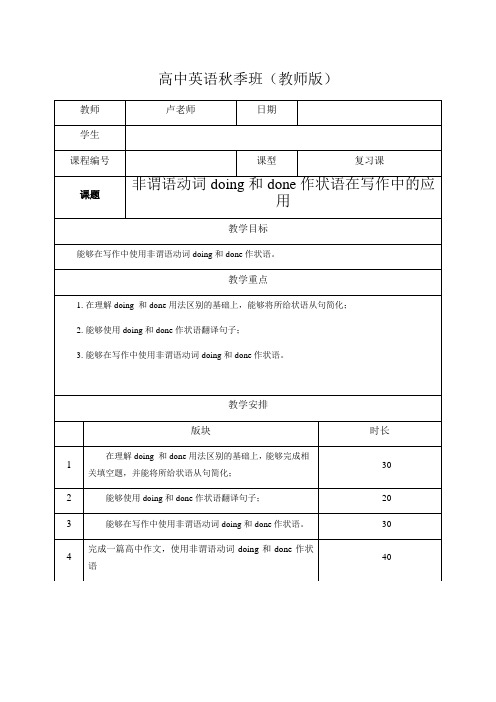
高中英语秋季班(教师版)知识点讲解一、用动词的适当形式填空:非谓语动词作状语大多相当于一个状语从句A.作时间状语:eg.)①_______ (hear) the bad news, they couldn’t help crying.= _______________, they couldn’t help crying.②When/ While( _____ _____ ) ____ (take) around the city, we were deeply impressed by the city’s new look.While/When (I was) _____ (wander) through the square, I caught sight of a snake-charmer.③_______ (finish) his work, he went home.=_____________, he went home.B.作原因状语:Eg.) ①_____ (be poor), he could not afford to travel abroad.=____________, he could not afford to travel abroad.________ (encourage) by his heroic deeds, they worked harder._______ (lose) in thought, he almost ran into a post.________ (frighten) by the big forest fire, the animals all ran away._____ (not know) her address, we couldn't get in touch with her.②______ (never be) to the city, he soon got lost._________ (not receive) his letter, I decided to call him up.=_____________.C.方式/伴随状语;Eg.)①She watched the film, _____ (weep ) and ___ (sigh).②The teacher stood there, ______ (surround) by a lot of students.D.作条件状语:Eg.)①______ (give) another chance, I would have done the job far better.=______________ , I would have done the job far better.②(If) _____ (play) all day, you will waste your valuable time.E.作结果状语:(意料中的结果)Eg.)① The hunters fired, _____(shoot) one of the wolves.②The bus was held up by the snowstorm, thus _____ (cause) the delay.区别: 不定式表示意外的结果eg.) He hurried to the station, only ____ (find) the train had left.F.作让步状语:Eg.)①Though ____ (rain) heavily, it cleared up very soon.= _____________, it cleared up very soon.②Though _____ (tell) of the danger, he still risked his life to save the boy.分词作状语时, 需注意事项:A.分词短语作状语时,它的逻辑主语通常应是________ :____ (see) from the hill, the city is beautiful.___ (see) from the hill, you can see the whole city二、使用doing和done简化以下状语从句:1. When arriving, send me a telegram. (When you arrive, send me a telegram.) 到达之后,来个电报。
非谓语动词做题技巧

1. (2011陕西卷) More highways have been built in China,______ it much easier for people to travel from one place to another. A. making B. made C. to make D. having made A
C. to be studying
B. to study
D. to have been studying
原则七:用于名词后作定语时,原则是: 用不定式,表示动作尚未发生; 用-ing,表示动作正在进行; 用过去分词,表示动作被动、完成。 1.There will be more than three hundred scientists
hoping 1. Write to the editor, ________ that the editor would be able to help her.( hope ) 2.She reached the top of the hill and stopped to rest there _________ on a big rock.( rest ) 3.The secretary worked late into night , preparing ______
2.(2011浙江卷,3) Bats are surprisingly long-lived creatures some _______ a life span of around 20 years. A. having B had C. have D. to have
-ing形式作伴随状语与 to do作目的状语的区别: 作伴随状语的-ing形式与谓语动词的动作同时发生且 前面常常带一逗号;而作目的状语的不定式的动作要比 谓语动词的动作后发生, 前面不能用逗号。
非谓语动词作状语
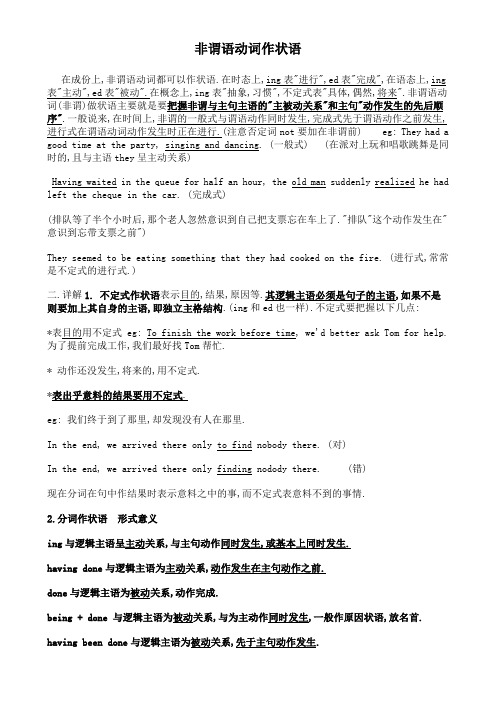
非谓语动词作状语在成份上,非谓语动词都可以作状语.在时态上,ing表"进行",ed表"完成",在语态上,ing 表"主动",ed表"被动".在概念上,ing表"抽象,习惯",不定式表"具体,偶然,将来".非谓语动词(非谓)做状语主要就是要把握非谓与主句主语的"主被动关系"和主句"动作发生的先后顺序".一般说来,在时间上,非谓的一般式与谓语动作同时发生,完成式先于谓语动作之前发生,进行式在谓语动词动作发生时正在进行.(注意否定词not要加在非谓前)eg: They had a good time at the party, singing and dancing. (一般式)(在派对上玩和唱歌跳舞是同时的,且与主语they呈主动关系)Having waited in the queue for half an hour, the old man suddenly realized he had left the cheque in the car. (完成式)(排队等了半个小时后,那个老人忽然意识到自己把支票忘在车上了."排队"这个动作发生在"意识到忘带支票之前")They seemed to be eating something that they had cooked on the fire. (进行式,常常是不定式的进行式.)二.详解1. 不定式作状语表示目的,结果,原因等.其逻辑主语必须是句子的主语,如果不是则要加上其自身的主语,即独立主格结构.(ing和ed也一样).不定式要把握以下几点:*表目的用不定式 eg: To finish the work before time, we'd better ask Tom for help. 为了提前完成工作,我们最好找Tom帮忙.* 动作还没发生,将来的,用不定式.*表出乎意料的结果要用不定式.eg: 我们终于到了那里,却发现没有人在那里.In the end, we arrived there only to find nobody there. (对)In the end, we arrived there only finding nodody there. (错)现在分词在句中作结果时表示意料之中的事,而不定式表意料不到的事情.2.分词作状语形式意义ing与逻辑主语呈主动关系,与主句动作同时发生,或基本上同时发生.having done与逻辑主语为主动关系,动作发生在主句动作之前.done与逻辑主语为被动关系,动作完成.being + done 与逻辑主语为被动关系,与为主动作同时发生,一般作原因状语,放名首.having been done与逻辑主语为被动关系,先于主句动作发生.eg: Given more time, he would finish the plan. 多给些时间他就能完成计划.Getting off the bus, she saw her mother. 一下车她就看见了她妈妈.Having passed the exam, she told everybody the good news.通过了考试后,她把这个好消息告诉了每个人.Having been told many times, she still couldn't understand me.跟她说了很多次她还是不能理解我的意思.Being asked to give a speech, she didn't know how to refuse.被邀做演讲时,她不知道怎么拒绝.注:以上各点也适用于非谓语动词做其它成份的情况.混合练习(按步骤:*找主语 *找主句谓语 *判断非谓与主语的主被动关系 *比较非谓和主句动作先后,对照上表来做就不容易出错了)1 _____ their service, the workers of the hotel are active in learning English.A. ImprovingB. To improveC. ImprovedD. Having improved【解析】本题考查非谓语动词作状语。
非谓语动词用法小结

非谓语动词用法小结非谓语动词包括不定式、动名词、分词(现在分词和过去分词),同时有着各种形式变化。
不定式:to do / to be doing / to be done / to have done / to have been done动名词:doing / having done / being done / having been done现在分词:同上过去分词:done一、主语(to do / doing)1、不定式作主语eg. To watch the TV play is very interesting. --- It’s very interesting to watch the TV play.2、动名词作主语eg. Walking on the moon is more difficult.It’s no use sending him to a hospital.I t’s a great deal of good practising English every morning.It’s a waste of time arguing with him.区别:1、表一般、抽象概念,用doing ; 表具体、个别动作,多用to do.eg. Reading good books makes us happy.To read this book is very interesting.2、在疑问句中多用doing.eg. Did her being late make her teacher angry?3、不定式在疑问句或感叹句中作主语,只能用it作形式主语。
eg. To watch the TV play is interesting. --- Is it interesting to watch the TV play? --- How interesting it is to watch the TV play!二、宾语(to do / doing)1、直接接不定式作宾语的动词有:wish, hope, refuse, manage, plan, fail, offer, promise, pretend, decide, learn, agree, mean (打算), determine, expect, afford……eg. Jenney tried to explain.The boy pretended to have finished it.2、需用it代替不定式作宾语的动词有:find, make, think, consider, feel……eg. He found it important to study the situation in Russia.3、接动名词作宾语的动词有:suggest, finish, avoid, mind, enjoy, practice, appreciate, miss, advise, consider, keep, delay, escape, excuse, imagine, risk, resist……eg. The boy crossed the street to avoid meeting his teacher.4、既可接不定式又可接动名词作宾语的动词有:begin, start, like, love, hate, prefer, continue, want, need, require, remember, forget, regret, try……eg. When did you begin to learn / learning English?I want to repair the house. / The house wants repairing.三、定语(to do / doing / done)1、不定式作定语与所修饰的名词存在动宾、主谓或所属关系。
高考英语非谓语动词做状语

非谓语动词包括---ing分词、过去分词及不定式,他们不受句子主语的人称和数的影响,不能在句子中作谓语;但具有动词的特征(有时态和语态的变化形式),又具有名词、形容词或副词的特性,所以可以在句子中担任其他语法功能,如在句子中做主语、定语、补语或状语等,下面就其作状语的用法进行分类归纳。
非谓语动词作状语的用法可以用下面图表表示:非谓语动词表主动意义 Doing sth., 主语 + 谓语。
作状语 Having done sth., 主语 + 谓语。
表被动意义 Done, 主语 + 谓语。
Having been done, 主语 + 谓语。
表目的、结果 to do sth.现在,再来详细讲解其用法。
一、表主动意义的Doing sth.与Having done sth1. Doing sth. 表示分词的动作与主句的动作同时或几乎同时发生(虽有先后关系,但两个动作非常紧凑),我们可以用“主动、进行”来记住—ing分词作状语的用法。
.eg: We were sitting by the window, talking about what happened yesterday.(sitting 与talking about两个动作同时进行,talking about …作伴随状语)A crowd of children ran out of the classroom, laughing and talking merrily.(同时进行的动作,作方式状语)Hearing the cry for help, they all rushed out.(Hearing与 rushed out两个动作虽有先后关系,但非常紧凑,hearing…作原因状语) doing 有时只表“主动”并无进行之意。
eg: Seeing on the top of the mountain, you’ll find our city beautiful.Being a student, I must study hard.2. Having done sth.表示分词的动作比主句的动作先发生,强调“主动、完成”。
- 1、下载文档前请自行甄别文档内容的完整性,平台不提供额外的编辑、内容补充、找答案等附加服务。
- 2、"仅部分预览"的文档,不可在线预览部分如存在完整性等问题,可反馈申请退款(可完整预览的文档不适用该条件!)。
- 3、如文档侵犯您的权益,请联系客服反馈,我们会尽快为您处理(人工客服工作时间:9:00-18:30)。
高中英语秋季班(教师版)
教师卢老师日期
学生
课程编号课型复习课
课题非谓语动词doing和done作状语在写作中的应
用
教学目标
能够在写作中使用非谓语动词doing和done作状语。
教学重点
1.在理解doing 和done用法区别的基础上,能够将所给状语从句简化;
2.能够使用doing和done作状语翻译句子;
3.能够在写作中使用非谓语动词doing和done作状语。
教学安排
版块时长
1在理解doing 和done用法区别的基础上,能够完成相关填
空题,并能将所给状语从句简化;
30
2能够使用doing和done作状语翻译句子;20 3能够在写作中使用非谓语动词doing和done作状语。
30
4完成一篇高中作文,使用非谓语动词doing和done作状
语
40
知识点讲解
一、用动词的适当形式填空:
非谓语动词作状语大多相当于一个状语从句
A.作时间状语:
eg.)①_______ (hear) the bad news, they couldn’t help crying.
= _______________, they couldn’t help crying.
①When/ While( _____ _____ ) ____ (take) around the city, we were deeply impressed by the city’s new look.
While/When (I was) _____ (wander) through the square, I caught sight of a snake-charmer.
①_______ (finish) his work, he went home.
=_____________, he went home.
B.作原因状语:
Eg.) ①_____ (be poor), he could not afford to travel abroad.
=____________, he could not afford to travel abroad.
________ (encourage) by his heroic deeds, they worked harder.
_______ (lose) in thought, he almost ran into a post.
________ (frighten) by the big forest fire, the animals all ran away.
_____ (not know) her address, we couldn't get in touch with her.
①______ (never be) to the city, he soon got lost.
_________ (not receive) his letter, I decided to call him up.
=_____________.
C.方式/伴随状语;
Eg.)①She watched the film, _____ (weep ) and ___ (sigh).
①The teacher stood there, ______ (surround) by a lot of students.
D.作条件状语:
Eg.)①______ (give) another chance, I would have done the job far better.
=______________ , I would have done the job far better.
①(If) _____ (play) all day, you will waste your valuable time.
E.作结果状语:(意料中的结果)
Eg.)① The hunters fired, _____(shoot) one of the wolves.
①The bus was held up by the snowstorm, thus _____ (cause) the delay.
区别: 不定式表示意外的结果
eg.) He hurried to the station, only ____ (find) the train had left.
F.作让步状语:
Eg.)①Though ____ (rain) heavily, it cleared up very soon.
= _____________, it cleared up very soon.
①Though _____ (tell) of the danger, he still risked his life to save the boy.
分词作状语时, 需注意事项:
A.分词短语作状语时,它的逻辑主语通常应是________ :
____ (see) from the hill, the city is beautiful.
___ (see) from the hill, you can see the whole city
二、使用doing和done简化以下状语从句:
1. When arriving, send me a telegram. (When you arrive, send me a telegram.) 到达之后,来个电报。
2. After I had worked out the math problem, I went to sleep. Having worked out the math problem, I went to sleep.
3. Before leaving, turn off all the lights. (Before you leave, turn off all the lights.) 走之前,请关闭所有的灯。
4. Don’t come in until (you are) asked to. 不叫你请你不要进来。
5. He will come if (he is) asked. 如果叫他来,他就来。
6. If (it is) necessary, ring me at home. 如果有可能,朝我家里打电话。
7. While (he was) holding talks with President Hu Jintao , US President George W. Bush thanked China for its important role in the Six-Party Talks.美国总统布什在与胡锦涛主席会谈时,感谢中国在六方会谈中起的重要作用。
8. The exhibition is more interesting than (it was) expected .这次展览比被预料的有趣的多
9. She has finished the work earlier than (it has been ) expected.
三、翻译以下句子,使用doing和done的形式。
1.The books were long and dull. Benjamin could read only a little,having been a poor student. (2017浙江高考)
2.And then came the lesson. I’ve taken with me through my life: “Honey, Your basket is extra-special,”Mom said, gently wiping away my hot tears.”Your basket is special because you paid for it yourself.”(2016浙江高考)
四、改写句子
We may have different opinions in organizing class activities. We may have various ways to deal with such a situation. When I have a better idea, I would choose to stick to it. By doing so, I can not only share good ideas with others but also learn to express myself clearly.
Once we were discussing where to go for an outing. Most of my classmates wanted to go to a park while I had an idea of going to a nicer place. I managed to persuade my classmates into accepting my idea. We did have a good time that day. Good opinions are worth sticking to because they can benefit us all.。
